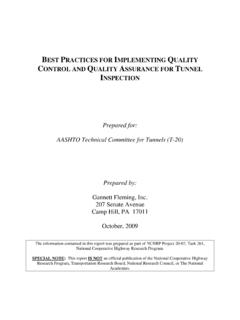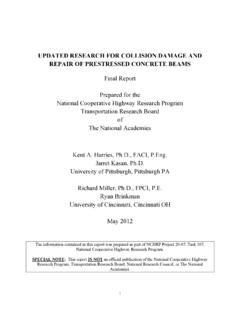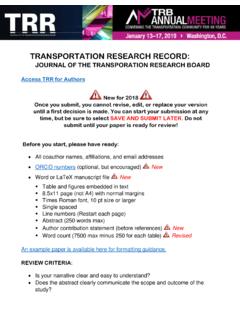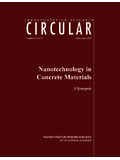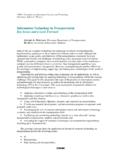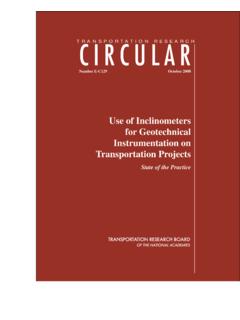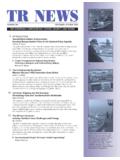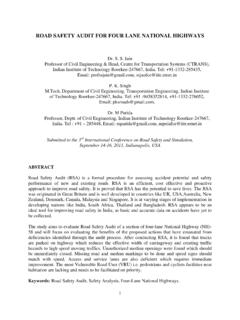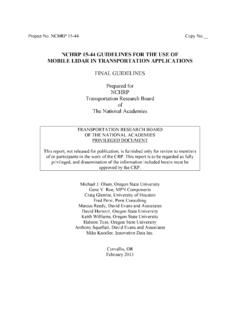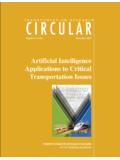Transcription of GUIDELINES FOR DESIGN AND CONSTRUCTION OF DECKED …
1 Project No. 12-69 COPY NO. ___ GUIDELINES FOR DESIGN AND CONSTRUCTION OF DECKED PRECAST, PRESTRESSED CONCRETE GIRDER BRIDGES FINAL REPORT Prepared for National Cooperative Highway Research Program Transportation Research Board National Research Council Oesterle and Elremaily CONSTRUCTION Technology Laboratories, Inc. 5400 Old Orchard Road, Skokie, IL 60077 In Association with: Roy Eriksson, Eriksson Technologies, Inc. Chuck Prussack, Central Pre-Mix prestress Co. Z. John Ma, University of Tennessee, Knoxville July 30, 2009 i Project No. 12-69 GUIDELINES FOR DESIGN AND CONSTRUCTION OF DECKED PRECAST, PRESTRESSED CONCRETE GIRDER BRIDGES FINAL REPORT Prepared for National Cooperative Highway Research Program Transportation Research Board National Research Council Oesterle and Elremaily CONSTRUCTION Technology Laboratories, Inc.
2 5400 Old Orchard Road, Skokie, IL 60077 In Association with: Roy Eriksson, Eriksson Technologies, Inc. Chuck Prussack, Central Pre-Mix prestress Co. Z. John Ma, University of Tennessee, Knoxville July 30, 2009 ii ACKNOWLEDGMENT OF SPONSORSHIP This work was sponsored by the American Association of State Highway and Transportation Officials, in cooperation with the Federal Highway Administration, and was conducted in the National Cooperative Highway Research Program, which is administered by the Transportation Research Board of the National Research Council. DISCLAIMER This is an uncorrected draft as submitted by the research agency.
3 The opinions and conclusions expressed or implied in the report are those of the research agency. They are not necessarily those of the Transportation Research Board, the National Research Council, the Federal Highway Administration, the American Association of State Highway and Transportation Officials, or the individual states participating in the National Cooperative Highway Research Program. iii TABLE OF CONTENTS Page LIST OF FIGURES .. VI AUTHOR ACKNOWLEDGEMENTS .. VIII ABSTRACT .. IX EXECUTIVE SUMMARY .. 1 CHAPTER 1 .. 3 PRELIMINARY ASSESSMENT .. 3 DESIGN CRITERIA .. 3 DESIGN Specifications.
4 3 Loads .. 3 Roadway Geometry .. 3 SITE ASSESSMENT .. 4 Accessibility of Site .. 4 Vertical Clearance Requirements .. 4 Water Crossing Issues (hydraulics, shoreline, etc.) .. 4 Permitting and Environmental Issues .. 5 COORDINATION WITH LOCAL PRECAST PRODUCERS AND CONTRACTORS .. 5 Availability of Product Types .. 5 Material Properties .. 5 Prestressing Systems and Conventions .. 6 DESIGN Conventions .. 6 Trucking Capabilities, Shipping Distance .. 6 Crane Availability and Rates .. 6 Preliminary Cost Estimates .. 7 CHAPTER 2 .. 10 SYSTEM CONFIGURATION .. 10 STRUCTURAL SYSTEM.
5 10 Continuity .. 10 Girder Splicing .. 11 Provisions for future Redecking .. 12 GIRDER SIZE AND SPACING .. 13 Selection of Girder Depth and Depth Limitations .. 13 Weight Limitations .. 13 Length Limitations .. 14 DIAPHRAGMS .. 14 Concrete Diaphragms .. 15 Steel Diaphragms .. 15 iv TABLE OF CONTENTS (continued) JOINTS .. 15 15 Transverse .. 16 BEARINGS .. 16 BARRIER AND RAILING SYSTEMS .. 16 Parapets .. 17 Post and Rails Barriers .. 17 PROVISIONS FOR BRIDGE WIDENING .. 17 BRIDGE AND GIRDER GEOMETRY CONTROL .. 17 Girder Camber .. 17 Bridge Skew.
6 19 Bridge Cross Slope .. 19 Girder Asymmetry .. 20 OVERLAYS .. 20 Water-Proofing Membrane .. 20 CHAPTER 3 .. 34 FABRICATION AND CONSTRUCTION .. 34 GIRDER FABRICATION .. 34 Forming .. 34 Prestressing .. 35 Embedded Hardware .. 35 Concrete Placement .. 35 TRANSPORTATION .. 36 Girder Stability .. 36 ERECTION SCHEMES .. 36 GIRDER INSTALLATION .. 36 Girder Continuity Connections .. 36 Conventional Weld Plate Joints .. 37 Headed Bar Joints .. 39 future RE-DECKING .. 43 Deck Removal .. 43 System Stability .. 45 Placement of New Deck .. 46 CHAPTER 4 .. 58 DESIGN THEORY AND PROCEDURES.
7 58 MATERIAL PROPERTIES .. 58 Concrete .. 58 SECTION PROPERTIES .. 58 LOADS .. 59 Temporary CONSTRUCTION Loads .. 59 Live Load .. 62 v TABLE OF CONTENTS (continued) Structural Systems .. 68 PRESTRESSING LAYOUT .. 75 Pretensioning .. 75 prestress LOSSES .. 76 Loss Components .. 76 Simplified Methods .. 78 Detailed Method .. 78 STRESSES .. 78 Concrete Stress Limits .. 79 FLEXURAL STRENGTH .. 79 Flexural Capacity - Reinforcement Limits .. 79 SHEAR DESIGN .. 80 Vertical Shear .. 80 TOP FLANGE DESIGN .. 81 Flanges with Conventional Weld Plate Joints .. 81 Flanges With Headed Bar Joints.
8 83 REINFORCEMENT DETAILING .. 83 Typical Reinforcement .. 83 Bursting Reinforcement .. 84 Confinement Reinforcement .. 84 CAMBER AND DEFLECTIONS .. 84 CONNECTION DESIGN .. 85 Lifting Loops .. 85 Longitudinal Joint .. 85 DESIGNING AND DETAILING FOR future RE-DECKING .. 89 Flange Width .. 90 Shear Key DESIGN .. 90 REFERENCES .. 104 APPENDIX A - DESIGN Example for Simple Span Bridge APPENDIX B - DESIGN Example for Camber Leveling Clamp APPENDIX C - DESIGN Examples for future Re-Decking vi LIST OF FIGURES Figure 1-1. Typical DECKED bulb tee (DBT) cross section.. 8 Figure 1-2.
9 Typical hauling rig.. 8 Figure 1-3. Crane picking girder from truck.. 9 Figure 2-1. Integral abutments on a single-span bridge.. 21 Figure 2-2. Integral abutment detail.. 21 Figure 2-3. Typical DBT cross section with limits of variability.. 22 Figure 2-4. End diaphragm details.. 22 Figure 2-5. End diaphragm details.. 23 Figure 2-6. End diaphragm details.. 23 Figure 2-7. Access holes in deck to cast intermediate diaphragm.. 24 Figure 2-8. Intermediate diaphragm details.. 24 Figure 2-9. Section through intermediate diaphragm.. 25 Figure 2-10. Plant-cast diaphragm with field-welded connections.
10 25 Figure 2-11. Steel K-brace intermediate diaphragms.. 26 Figure 2-12. Bearing detail.. 26 Figure 2-13. Concrete parapet detail.. 27 Figure 2-14. Post and rail barrier.. 27 Figure 2-15. Railing connection detail.. 28 Figure 2-16. Embedded rail post anchorage plate details.. 28 Figure 2-17. Rail post anchorage plate details.. 29 Figure 2-18. Rail post anchorage.. 29 Figure 2-19. Girder camber can be increased using formwork.. 30 Figure 2-21. Pier elevation adjustment for a two-span bridge.. 31 Figure 2-22. Pier elevation adjustment for a three-span bridge.. 31 Figure 2-23. Upward camber of girder due to prestress .
